| Hi Juniper! Photo: Jeremy Dwyer-Lindgren/Woodland Park Zoo |
Editor’s note: Big thanks to Animal keeper Maddie Weholt for all the great info!
Whether it’s too expensive or for humans, a regular visit to the medical office is part of a good health and wellness routine. But what about when it’s for a 400-pound-and-stadical growing young brown bear? In July, our animal care team performed a complete routine physically on the well-known and well-known 2-½-year-old women’s and she passed her exam with flying colors! But what does a medical appointment look like for a big bear like Einer? Let’s take one behind the scenes look at all the ins, outs and in-Betweens on Junper’s Day on “Doctor’s Office.”
Apart from the medical treatment of illness or injury, all our animals get routine health and wellness control – but how often it happens depends on the species and what our veterinary staff recommend that best meet their needs. In the case of our brown bears, they are examined every 3 years, with Junipers up first and Ferns (Juniper’s BFF and “Housmate”) control, which is probably scheduled for next year.
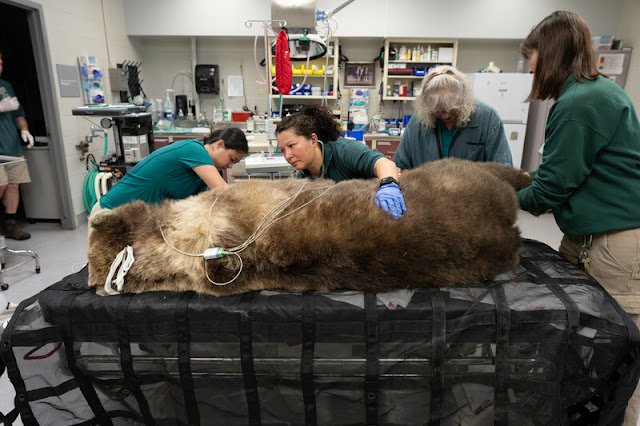 |
| Juniper got a thorough control at our animal hospital. Photo: Jeremy Dwyer-Lindgren/Woodland Park Zoo |
Transporting an animal to Woodland Park Zoo’s Veterinary Hospital is not always necessary or even possible for some of our larger Zoo residents. Our veterinarians have the ability to “make house calls” when needed – but the animal hospital is an ideal place for a medical control whenever possible. No matter where an exam takes place, one of the most important aspects of our animal health protocols is to ensure that the process is as stress -free as possible for our animals. This is regular training and trust building with animal holders and our veterinary staff come into play.
When they were kids, both fern and ein have voluntarily participated in almost daily or weekly separate training sessions (with lots of delicious treats involved!), Whereas they each lie in a behind the scenes that have small openings where trained staff can certainly touch different parts of their bodies. To be asked to “present” different body parts like their paws, the sides of their faces and open their mouths allow their care team the opportunity to get a good look at their entire bodies while they are awake.
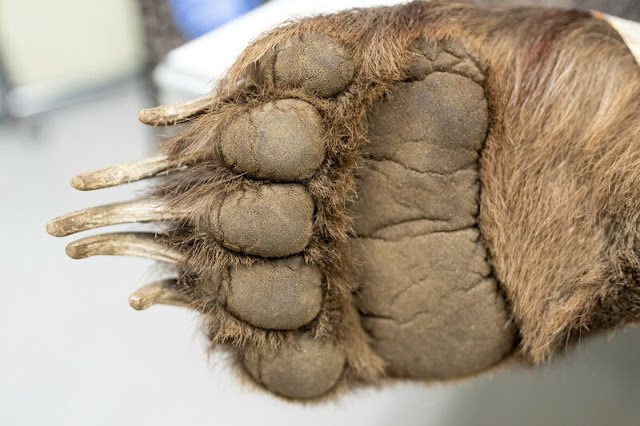 |
| Now it’s a big paw! Photo: John Loughlin/Woodland Park Zoo |
 |
| These large claws allow bears to dig roots, excavate its and more. Photo: John Loughlin/Woodland Park Zoo |
Both bears are used to being separated during these training sessions and when they eat. For training, separation allows you to focus 100% of their attention on one bear at a time. And in the meals, it allows the holders to make sure each bear gets enough to eat. Food such as greens and vegetables can be shared and eaten together, as the bears probably do not fight for these so -called “lower value” foods, but “foods with higher value” such as meat and fruit are always offered separately. This gives each bear some assurance that they do not have to compete with the other for food – an important necessity to maintain peace when housing carrier together.
A thorough health check requires a slightly more practical approach and then a training session, so that being desensibilized to be touched by the hip area — for example-provides our animal care staff to do things like administering vaccines or medicine without having to dart or stress them. This is how Juniper was hand -inued with anesthetic medicine in the morning after her exam. No fuss, no muss and she was soon to sound asleep.
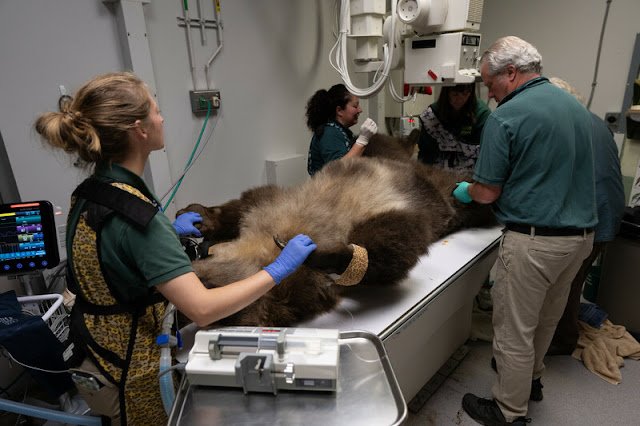 |
| Our staff provides first -class care of this very important patient. Photo: John Loughlin/Woodland Park Zoo |
Like a sub-grown-beer of our brown bear will be 3 years old this winter-is Juniper not quite cultivated yet, so this may be the last time she is actually “small enough” (a very relative expression in this case) to transport down to our hospital facility. According to Animal Keeper Maddie, who stayed with Junipers throughout her checkup, it took eight members of the animal care team to hoist her in and out of the animal ambulance (remember, she bells around 400 lbs.) And they also needed a few wagons with wheels to cover the distance between her exhibition and the vehicle plus the exam room at the animal house. She may still be on the young side, but she’s already a big girl just like she has to be!
During Juniper’s exam, our veterinary staff took blood and urine tests, listened to her heart and lungs, examined her teeth, took x -rays (X -rays) and performed an ultrasound to get a closer look at some of her organs. The conclusion? Juniper meets all normal and expected milestones for a growing brown bear under adults. In other words, she is in good shape! In total, the exam took a few hours to complete and Juniper was home in her Living Northwest Trail Habitat before noon.
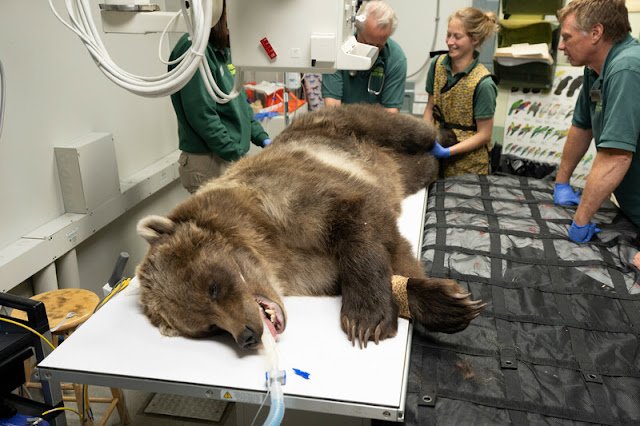 |
| During her exam, our veterinary staff and animal holders fit the juniper with great care. Photo: Jeremy Dwyer-Lindgren/Woodland Park Zoo |
All the time, Fern was cool like a cucumber while her bestie was gone. In the weeks before Junip’s July exam, our animal holders separated the bears for longer periods than usual, so Fern could get used to being out on the public side of the habitat for a while without Einer. It also made it possible for the holders to learn what Fern would need to stay busy and calm on their own so they could put her up to success!
On the day of the exam, Fernen got all her day’s value of food at once (usually her meals are separated) spread throughout the entire habitat area so she could have fun sniffing and feeding around. They also gave her all kinds of toys that she usually only has access to behind the scenes, and the hidden special delicious goodies like nuts around the entire exhibition. This strategy also made her super full and super -tired first thing in the morning – just like us after a big meal and playing SESH! So basically, Fern spent all the morning eating, playing with toys and naps – a bear’s favorite thing to do.
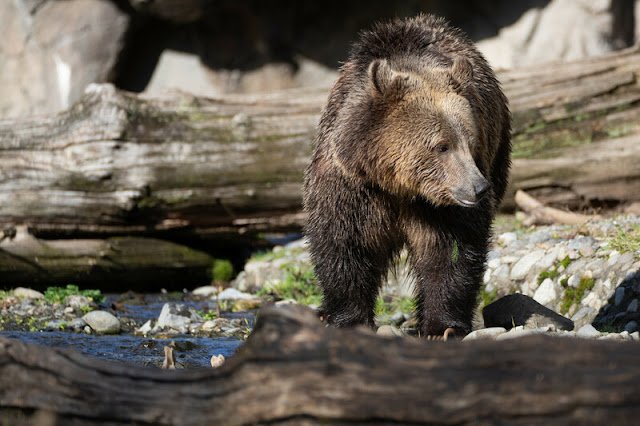 |
| Fern kept busy while her bestie got a health check. She spent her morning eating. Playing and lurking! Photo: Jeremy Dwyer-Lindgren/Woodland Park Zoo |
Fern and Juniper’s Reunion that afternoon was lovely and unexpected. When Einer was stable on her feet and walked around, she began to make a vocalization called a “contact call.” This is a kind of call between a mother and her kids or between littermates to help them keep an eye on each other. Fern heard Juniper’s Call, so the keepers let the girls have visual access to each other through a mesh door in their indoor possession area. They sniffed each other and licked each other’s faces through the net – which is (according to keeper Maddie) crazy sweet, but also a sign that none of them were annoyed or kept a nag from the separation. Obviously, Fern and Juniper were more than ready to be together again.
Once reunited, Fern and Juniper had access to the entire exhibition boats public and behind the “Hold” areas-but they chose to hang out in the holding area for a while. Juniper “celebrated” the reunion by throwing his favorite toy around the yard. (If you’ve seen Juniper for a period of time, you know she’s very good at throwing things in the air – food, sticks, plants – everything she gets hold of.) Later that night both bears swam in their pool together and the next day everything was back to business as usual.
The weight of a brown bear swings seasonally, and some wild bears have been documented to almost double their weight in the fall as they prepare for winter! Currently, Juniper is about 400 pounds and Fern is 50-70 pounds less. Despite the weight difference because they are from different populations (they are both brown bears-but ein is a coastal brown bear, and Bregn is Grizzly, which is another subspecies that tends to be less) Einer and fern are at the same age and should follow the same development timeline.
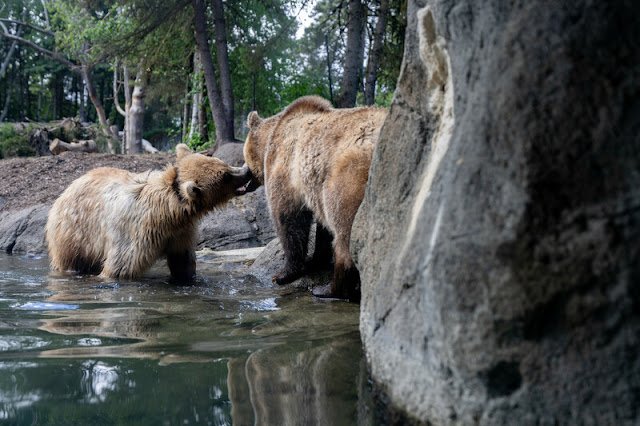 |
| At the end of the day, Fern and Juniper played together in their pool together. Photo: Jeremy Dwyer-Lindgren/Woodland Park Zoo |
Many people ask us how much we expect each of our bears to weigh when they have finished growing-brown bears mature around 4-5 years, so we would expect them to be grown fully before then. Any number would just be a guess at this point, so it’s a question that Keeper Maddie likes to answer with “I can’t wait to find out”! Whatever happens, we are so glad that Juniper’s Wellness exam went without any problems and that both girls thrive since arriving at Woodland Park Zoo as an orphan in 2022 (Juniper from Alaska and Fern from Montana). We think Keeper Maddie has the right idea, nor can we wait to see what the future brings to both of these violent girls.
